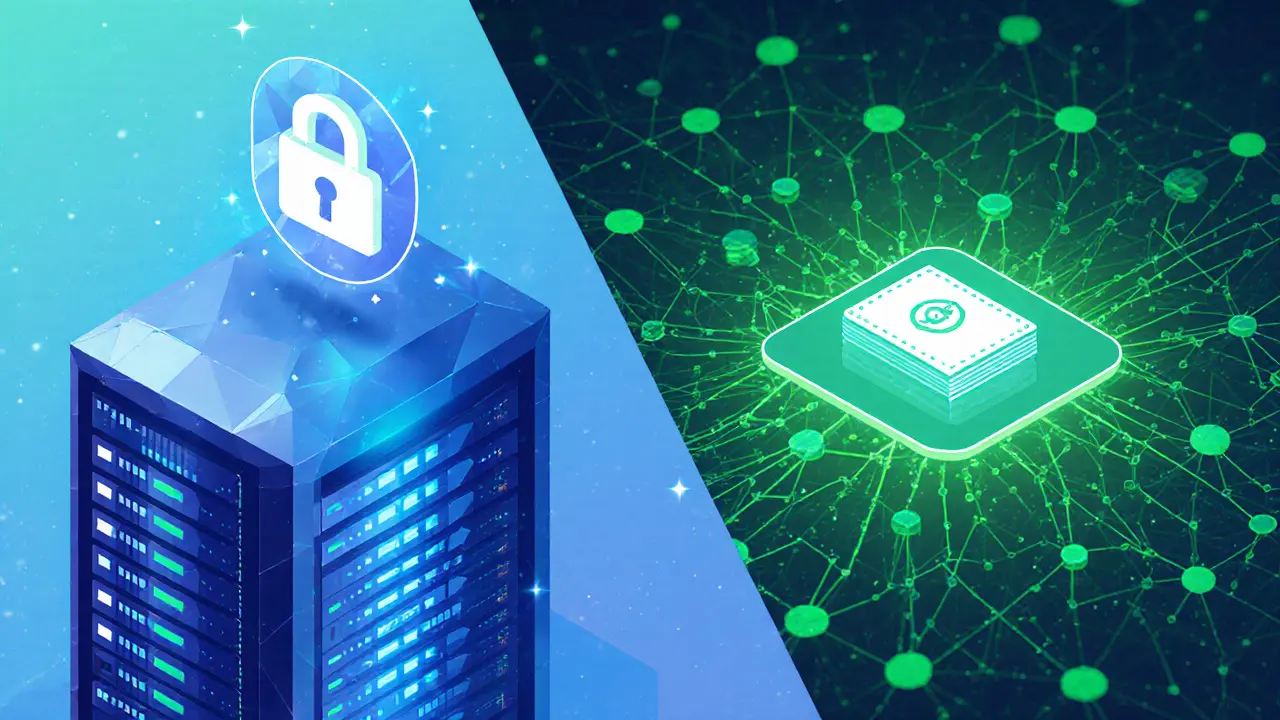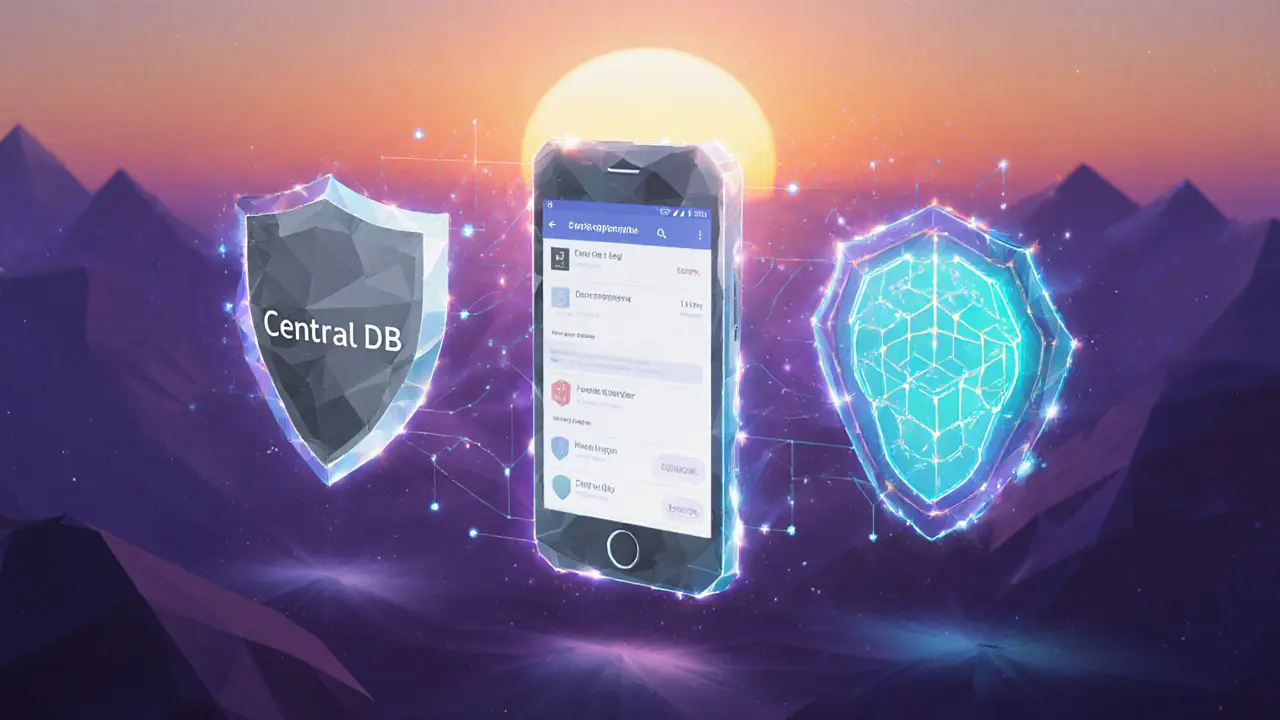DID vs Traditional Identity Systems: Key Differences Explained
 Feb, 6 2025
Feb, 6 2025
Traditional vs Decentralized Identity Comparison Tool
Traditional Identity
Centralized systems with established protocols and easy integration.
Decentralized Identity (DID)
User-controlled identity with enhanced privacy but complex implementation.
Traditional Identity Features
-
Security Architecture
Single repository - high breach risk
-
User Control & Privacy
Organization-owned data, limited user consent
-
User Experience
SSO across apps, simple login flow
-
Implementation
Established IAM tools, fast deployment
Decentralized Identity Features
-
Security Architecture
Distributed ledger - no single point of failure
-
User Control & Privacy
User-owned credentials, selective disclosure
-
User Experience
Wallet setup required, more steps initially
-
Implementation
Blockchain infrastructure, wallet integration
Key Comparison Summary
| Feature | Traditional Identity | Decentralized Identity |
|---|---|---|
| Security | Single point of failure | Distributed verification |
| Privacy | Data stored by organization | User-controlled, selective disclosure |
| Implementation | Mature tools, quick deployment | Blockchain integration required |
| Offline Capabilities | Requires live connection | Supported with cached keys |
| User Experience | SSO, familiar login | Wallet setup needed |
Decision Guide
Choose Traditional Identity If:
- You have existing IAM infrastructure
- Quick deployment is critical
- Simple user experience is prioritized
- You're working with regulated environments requiring compliance
Choose Decentralized Identity If:
- User privacy and control are top priorities
- You want to reduce data breach risks
- You're building innovative applications with strong privacy requirements
- You anticipate future regulatory shifts favoring user ownership
Trying to decide whether to stick with the old‑school login setup or jump to the new decentralized world? This guide breaks down the practical gaps between traditional identity management and Decentralized Identity (DID) so you can see which model fits your security, privacy, and user‑experience goals.
Quick Summary
- Traditional systems rely on a single authority that stores all credentials; a breach can expose millions of records.
- DIDs keep data in a user‑controlled wallet and use blockchain‑based verifiable proofs.
- Centralized IAM offers easy SSO and off‑the‑shelf integration; DIDs demand blockchain expertise and wallet adoption.
- Privacy is a core strength of DIDs - users share only what’s required, and they can revoke access instantly.
- Future road‑maps show both camps borrowing features, but the pull toward user‑owned identity is accelerating.
Below you’ll find a step‑by‑step walk‑through of each approach, a side‑by‑side comparison, and practical tips for rolling out the right solution in your organization.
What is a Traditional Identity System?
Traditional Identity System is a centralized framework where an organization collects, stores, and manages user attributes such as name, date of birth, and passwords in a single repository. These systems sit at the heart of most enterprise IAM (Identity and Access Management) stacks and use protocols like OAuth and OpenID Connect (OIDC) for federated authentication or SAML for single sign‑on across web apps. The user experience is familiar: you log in once and gain access to a suite of services via SSO.
Understanding Decentralized Identity (DID)
Decentralized Identity (DID) is a user‑centric identity model that replaces the central authority with cryptographically secured identifiers stored on a distributed ledger. Instead of passwords, users hold Verifiable Credentials in a digital wallet that they control on their device. When an app needs proof of age or citizenship, the wallet presents a zero‑knowledge proof that reveals only the required attribute, keeping the rest hidden.
The backbone of this model is Blockchain technology, which records DIDs and public keys on an immutable ledger, ensuring that no single party can alter the identity data. The ecosystem also includes Credential Issuer entities (government agencies, universities, banks) that sign credentials with their private keys, giving them cryptographic authority without ever storing user data centrally.
Core Technical Differences
Security Architecture: Centralized systems store hashes, passwords, and PII in one database - a classic single point of failure. Decentralized Identity spreads verification data across multiple nodes, making large‑scale theft virtually impossible.
User Control & Privacy: In the traditional model, users rarely know who sees their data after login. With DIDs, the Digital Wallet gives users the ability to grant, limit, or revoke access to each credential on demand.
Offline Verification: Traditional IAM requires a live connection to the identity provider for each login. DID‑based verification can happen offline because the wallet holds the cryptographic proof and the verifier only needs to check the issuer’s public key, which is cached locally.

Side‑by‑Side Comparison
| Dimension | Traditional Identity | Decentralized Identity (DID) |
|---|---|---|
| Security Architecture | Single repository - high breach risk | Distributed ledger - no single point of failure |
| User Control & Privacy | Organization‑owned data, limited user consent | User‑owned credentials, selective disclosure |
| User Experience | SSO across apps, simple login flow | Wallet setup required, more steps initially |
| Implementation Complexity | Established IAM tools, fast deployment | Blockchain infrastructure, wallet integration |
| Trust Model | Central authority trust | Cryptographic proof, trust in issuers only |
| Offline Verification | Requires live connection | Possible with cached public keys |
Benefits and Drawbacks of Traditional Identity
Pros
- Fast integration with existing enterprise software.
- Well‑understood protocols (OAuth, SAML) and mature tooling.
- SSO reduces password fatigue for users.
Cons
- Massive attack surface - a single breach leaks all stored PII.
- Limited user agency; organizations decide what gets shared.
- Compliance costs rise with data‑privacy regulations (GDPR, CCPA).
Benefits and Drawbacks of Decentralized Identity (DID)
Pros
- Zero‑knowledge proofs keep personal data private.
- Credentials are portable across services - no vendor lock‑in.
- Offline verification enables use cases like border control without internet.
Cons
- Initial user onboarding requires education about wallets.
- Blockchain performance and cost can be a hurdle for high‑throughput scenarios.
- Regulatory frameworks are still evolving.
Implementation Considerations
When evaluating a migration or a hybrid approach, ask yourself:
- Do we have the technical talent to manage a distributed ledger? If not, consider a SaaS DID platform that abstracts the blockchain layer.
- What user base will adopt a digital wallet? Pilot with a tech‑savvy segment before a full rollout.
- Which credentials need to be issued today? Start with low‑risk attributes (e.g., membership badges) and expand to high‑value IDs (driver’s license, passport).
- How will we handle revocation? Use the status list mechanism built into the W3C Verifiable Credential spec.
- What fallback exists for users without a smartphone? Provide a hardware wallet or a secure paper‑based QR code.
Future Outlook
Both camps are converging. Traditional IAM vendors are adding privacy‑enhancing tech like self‑sovereign identity plugins, while DID ecosystems are standardising selective disclosure protocols to smooth integration with legacy apps. The next wave of regulations is likely to favour solutions that give users explicit control over their data - a clear win for the decentralized model.

Frequently Asked Questions
Can I use DIDs with existing SSO solutions?
Yes. Many providers offer bridge services that translate DID proofs into OAuth tokens, allowing legacy applications to accept decentralized credentials without a full rewrite.
What happens if a user loses their digital wallet?
Recoverability is built into most wallet solutions via encrypted backups, biometrics, or social recovery mechanisms. The underlying DID remains on the blockchain; only the private key needs restoration.
Are DIDs compliant with GDPR?
Because personal data stays with the user and only non‑identifying proofs are shared, DIDs generally align well with GDPR’s data‑minimisation principles. However, issuers must still provide lawful bases for credential issuance.
How does cost compare between the two approaches?
Traditional IAM often involves licensing fees plus security‑incident costs if breached. DID solutions shift spending to blockchain transaction fees and wallet integration, which can be lower at scale but require upfront development investment.
Is offline verification truly secure?
Offline checks rely on cached issuer public keys and cryptographic signatures that cannot be forged. As long as the cached keys are authentic and the device’s clock is trusted, the verification remains tamper‑proof.


Lisa Stark
February 6, 2025 AT 06:48When you step back and look at the bigger picture, the tension between centralized and self‑sovereign identity mirrors the age‑old debate between trust in institutions and individual autonomy. Both systems aim to prove who you are, yet they take opposite routes – one hands you a key from a trusted gatekeeper, the other lets you carry the key yourself.
In practice, the choice often boils down to how much control you want over your own data versus how much convenience you need from a seamless login flow.
Logan Cates
February 10, 2025 AT 04:31Sure, the blockchain thing is just a fad to make us all wear digital wallets.
Joel Poncz
February 14, 2025 AT 02:14i get why folks are scared of losing their wallet but most apps now have backed‑up recovery phrases, so it’s not as scary as it seems.
Kris Roberts
February 17, 2025 AT 23:57Honestly, the whole DID buzz is cool, but if you ask me, the real win is when you can hop between services without re‑entering your password every time – that’s the future.
lalit g
February 21, 2025 AT 21:39Both models have merit; the key is to match the solution to the user base. A tech‑savvy crowd might love self‑sovereign ID, while a corporate environment may stick with the tried‑and‑true IAM tools.
Reid Priddy
February 25, 2025 AT 19:22It’s funny how the “privacy‑first” narrative ignores the fact that anyone can still be tracked through metadata, so don’t pretend DIDs are a silver bullet against surveillance.
Shamalama Dee
March 1, 2025 AT 17:05If you’re starting a pilot, begin with low‑risk credentials such as membership badges. This lets users get comfortable with wallet flows before you ask for something as sensitive as a driver’s license.
scott bell
March 5, 2025 AT 14:48The excitement around verifiable credentials is real but don’t overlook the engineering overhead – you need a reliable revocation list, key rotation, and a smooth UI, otherwise users will abandon the system.
Christine Wray
March 9, 2025 AT 12:31From a user standpoint, the biggest friction point is still the initial wallet setup. A guided onboarding experience can make that step feel less intimidating.
roshan nair
March 13, 2025 AT 10:14In practice, integrating DIDs with existing SSO stacks often involves a translation layer that converts verifiable credentials into OAuth tokens. This approach lets legacy applications continue operating while benefiting from the privacy guarantees of self‑sovereign identities.
Jay K
March 17, 2025 AT 07:57It is advisable to conduct a thorough risk assessment before replacing a mature IAM system, ensuring that regulatory compliance requirements are satisfied throughout the migration process.
Navneet kaur
March 21, 2025 AT 05:39if user looses his phone the whole system break, need backup.
Marketta Hawkins
March 25, 2025 AT 03:22Listen, folks – you think your data is safe with a big corporation? 😂 The only thing more fragile than a centralized DB is a user‑managed wallet that you can lose in a coffee shop. 🤦♀️
Drizzy Drake
March 29, 2025 AT 01:05Okay, let me walk through why the conversation around DIDs and traditional identity often feels like two sides of the same coin, but with very different etchings on the surface. First, think about the user experience: with a conventional SSO, you type your password once and you’re granted access to a whole suite of apps – it’s simple, it’s familiar, and it works because the backend knows exactly where to look for your credentials. Now, contrast that with the DID model where the user is handed a digital wallet, a cryptographic key pair, and a collection of verifiable credentials that live on the user’s device. The learning curve is steeper, sure, but the payoff is that the user can present a proof of age, membership, or any attribute without ever exposing the raw data, thanks to zero‑knowledge proofs.
Security, on the other hand, follows a similar dichotomy. In the centralized world, a single breach can expose millions of passwords and personal details; the attack surface is massive but well‑understood, and there are mature tools for defense. In the decentralized world, the attack surface shifts to the endpoints – the wallets – and while the ledger itself is immutable, the risk is in key management: lose the private key, lose the identity. However, modern wallets now incorporate social recovery and multi‑factor safeguards that mitigate this risk dramatically.
From a compliance perspective, regulators like GDPR value data minimization, which aligns nicely with the selective disclosure capabilities of DIDs. You can prove you’re over 18 without handing over your full birthdate, satisfying both legal requirements and user privacy. Yet, the lack of a universal standard for revocation and credential expiration can cause headaches for auditors who are used to a central log of who accessed what.
Implementation costs also differ. Traditional IAM can be licensed and deployed quickly, often with off‑the‑shelf integrations for popular SaaS platforms. DID solutions, however, demand blockchain infrastructure, which may involve transaction fees and the need to stay current with evolving standards like the W3C Verifiable Credentials data model. Many vendors now offer “DID‑as‑a‑service” to abstract away the blockchain complexity, but that adds another vendor lock‑in to consider.
Finally, let’s not forget the human factor. Users are accustomed to passwords; they don’t want to juggle seed phrases unless the payoff is clear. Education, intuitive UI, and fallback mechanisms – such as hardware wallets or secure paper backups – are essential to drive adoption. In summary, the decision isn’t binary; many organizations are opting for hybrid approaches that keep the reliable SSO for low‑risk services while rolling out DIDs for high‑privacy use cases like health records or financial KYC. The future will likely be a tapestry where both models coexist, each playing to its strengths.
AJAY KUMAR
April 1, 2025 AT 22:48The drama of reclaiming personal data is real – imagine a world where the government can’t hoard your info because you hold the key. That’s the power DIDs promise, even if the journey feels like climbing a mountain.
bob newman
April 5, 2025 AT 20:31Sure, the crypto crowd says it’s the end of surveillance capitalism, but let’s be honest – the same tech can be weaponized for mass tracking if a nation‑state decides to run a ledger on every citizen.
Anil Paudyal
April 9, 2025 AT 18:14simple: start small, test, then expand.
Kimberly Gilliam
April 13, 2025 AT 15:57its just another tech hype cycle
Jeannie Conforti
April 17, 2025 AT 13:39Try to keep the onboarding simple – a short video can help users understand wallet setup without feeling overwhelmed.
Zack Mast
April 21, 2025 AT 11:22One could argue that the very act of assigning a decentralized identifier is a philosophical statement about personal sovereignty, yet in practice the technology often mirrors the very structures it aims to dismantle.
Parker DeWitt
April 25, 2025 AT 09:05Honestly, the only thing standing between us and true user control is the inertia of legacy systems 🚀💥
Allie Smith
April 29, 2025 AT 06:48Stay optimistic – every new barrier we break brings us closer to a world where our data works for us, not against us.